|
Let’s Go Out for … Thai
This spicy cuisine can be both interesting and healthy — if you order wisely.
Article By: Jeffery Lindenmuth
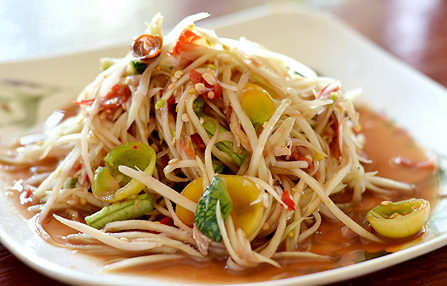  A lot of today’s restaurant cuisine emphasizes simplicity of preparation and flavors, but Thai food sits proudly at the opposite end of that spectrum. “Thai cuisine is about finding balance among a lot of strong flavors. In almost every dish, you will find sweet, sour, salty and spicy flavors all coming together,” says chef David Bank, a native of Thailand who owns the Land Thai and PURE Thai Shop House restaurants in New York City.
According to Bank, Thai cuisine is a melting pot of Asian influences from neighboring ethnic cuisines, drawing on Chinese cooking traditions and Indian curries from the north, as well as Vietnamese cuisine and the spicy heat of Malaysian cookery. With such a rich wealth of ingredients and influences, there are bound to be some that are nutritionally good, and others not so, notes Vandana R. Sheth, RD, nutrition educator and spokesperson for the Academy of Nutrition and Dietetics. “With a foundation of noodles and rice, often laced with sugar, Thai cuisine can be heavy in terms of carbs. However, it also offers lots of options for lean protein and fresh vegetables, so it can be light or heavy, depending on making the right selections,” says Sheth.
The great news about classic Thai menu items? There’s not a boring bite in the bunch. Even the healthiest options pack lots of flavor, and with a little sound advice you can avoid dietary stumbles and lighten up the more decadent dishes. The below Thai favorites can be found in most places, from white tablecloth restaurants to street carts. Appetizers 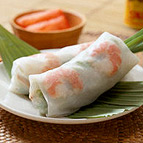 Thai Spring Roll (Po Pia Tod)
These Thai apps are popular as both street food and fine dining fare, made by filling a rice paper wrapper with a combination of flavors like mushrooms, bean sprouts and shrimp(although vegetarian options and pork or chicken versions are also available). Sounds great — then they hit the fryer to become crispy, golden brown, creating the Thai version of a Chinese eggroll with 5 PointsPlus values each. Lighten it up: Borrowed from Vietnamese cuisine, Thailand also offers fresh spring rolls (Po Pia Sot), which forgo the frying. At about 80 calories each, they offer the same great fillings, at only 2 PointsPlus values. 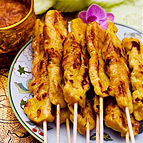 Satay Skewers
According to Bank, these bits of protein on a stick get their flavor by marinating beef or chicken chunks overnight with turmeric, a little palm sugar, salt, coconut milk and bay leaf. The downfall is that after grilling, they are traditionally served smothered with peanut sauce, so two skewers will run 12 PointsPlus values. Lighten it up: Leave off the offending peanut sauce and two skewers drops to only 5 PointsPlus values for beef and just 3 PointsPlus values for chicken. Better yet, get the sauce on the side and enjoy a taste, adding 1 PointsPlus value for each tablespoon used.
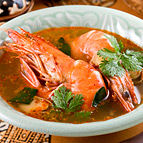 Hot and Sour Soup (Tom Yum Goong)
This spicy and sour soup has many variations across Thailand and its neighbors. According to Sheth, the combination of lean whole prawns (think jumbo shrimp), chilis and kaffir lime is a healthful choice, with one cup offering up to 24 grams of protein and just 4 PointsPlus values. “One danger here is that the fish paste used for flavoring can impart a lot of sodium,” says Sheth. Lighten it up: Already a good option as it is, just be wary of more modern variations of Tom Yum, like Tom yam namkhon, which adds coconut milk to an otherwise great choice.
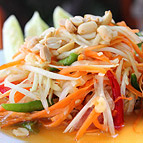 Green Papaya Salad (Som Tam Thai)
This salad of sliced green papaya has many variations, but according to Bank is always prepared by crushing the papaya with a mortar and pestle, while adding flavorful ingredients like garlic, spicy chilis, lime juice and palm sugar. Peanuts deliver crunch while fish sauce makes it savory and salty. With 4 grams of fiber and all the classic flavors of Thai cuisine, this dish could be described with that rare oxymoron “exciting salad,” all while serving up only 4 PointsPlus values. Lighten it up: In Thai street cuisine, and often in the U.S., this salad is served with a side of sticky rice or noodles. If you're having it as a meal, fine. Otherwise, pass on that cup of rice to avoid adding 5 PointsPlus values.
Main Entrees 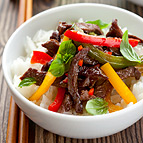 Stir Fry Beef with Thai Basil (Pad Kra Pow)
With the distinct licorice flavor of Thai basil, a shot of oyster sauce, plenty of garlic and Thai chilis, this dish delivers big flavor according to Bank. Because it is made a la minute (that’s “to order”) you’ll likely be asked how spicy you’d like the chef to prepare it. That kind of opportunity opens the gateway for additional alterations and substitutions, suggests Sheth. A restaurant version is typically heavy on the beef, with about 5 oz. of beef and 3 oz. of vegetables, meaning you could be looking at 21 PointsPlus values or more —before adding rice. Lighten it up: With any stir-fry, it can’t hurt to ask them to go easy on the oil. Each Tbsp. spared removes 120 calories, a savings of 3 PointsPlus values. “Request extra vegetables. You are going to eliminate some beef by replacing it,” says Sheth. With these two moves, you should get the dish down to a more reasonable 13 PointsPlus values.
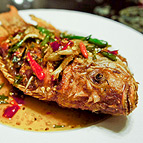 Fried Whole Fish with Chili and Tamarind Sauce (Pla Rad Prig)
This dish is as dramatic in presentation as it is in flavor. It’s typically made in the U.S. using a whole red snapper or Barramundi, which is flavored with a mix of tart tamarind paste, sweet palm sugar and spicy chilis before being deep fried. “If you are looking to splurge and enjoy this dish, ask if the fish is fresh. A frozen fish could turn out to be a wasted experience,” says Bank. Nutritionally speaking, “Fried says it all,” says Sheth, noting this is a tough dish to estimate. We’re going to try: with a whole fish of about 1 1/4 pounds, you’ll get two filets with 63 g of protein, but the frying fat will up the tally to 16 PointsPlus values. Lighten it up: “Fish is a great choice, so why not choose one that is sautéed or, ideally, steamed,” says Sheth. A single satisfying steamed filet, served with rice and vegetables, will be more like 8 PointsPlus values.
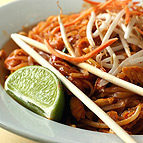 Pad Thai
For many, this noodle dish is the gateway to Thai cuisine. With slippery rice noodles coated with oil, firm egg and meat protein, and a topping of crunchy peanut, it’s a delicious and highly textural treat. Like many dishes, however, the portion expectation in the U.S. has grown, according to Bank. “In Thailand this is a few bites, but here it is a main course, and often gets lots of additions, like chicken,” he says. Even optimistic counts put a 10 oz. restaurant portion with chicken at 10 PointsPlus values. If you get this from a greasy food court or Chinese take-out, which increasingly offer Thai facsimiles, you can count on another 5 PointsPlus values for added fat from oil. Lighten it up: “This is actually a fairly good dish because the combination of fat, protein and carbs in one bite can be very satisfying,” says Sheth. Try to avoid the trap of the super-sized portion. You may want to commit to “divide and conquer” with your mountain of noodles, saving half for another meal.
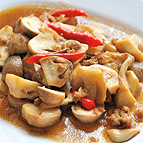 Massaman Curry
This comfort food of southern Thailand is in the Indian tradition of curry spice blends according to Bank. “The difference with Thai cuisine is we add coconut milk and palm sugar to balance the heat,” he says. While those cooling flavors make a great culinary contrast, Sheth declares this one a splurge. “This is one of the richest dishes available, with coconut milk and coconut cream adding saturated fats. And, it often has calorie intense meats, like fatty beef, duck or dark-meat chicken.” Just single-cup portion with beef will contain 21 PointsPlus values. You could well get two cups.
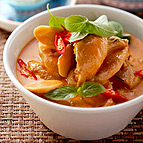 Red Curry
If you’re in the mood for curry, red curry with vegetables is one of the better choices, according to Sheth. This curry usually has coconut milk, but not cream. By choosing vegetables or chicken over beef, you’ll have a meal of about 700 calories. “Eat it with a fork, not a spoon, so you are enjoying the flavor but not slurping up every drop of fat,” suggests Sheth. With these tips, you can enjoy a one-cup portion for about 11 PointsPlus values.
Sides 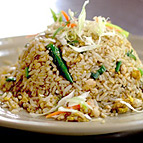 Thai Fried Rice (Khao Phat)
Throughout its variations, Thai fried rice comes bursting with the scents and flavors of Thailand, most notably aromatic Jasmine rice. A typical two-cup restaurant portion, with a lean protein like chicken, will be about 18 PointsPlus values, but adding favorite flavorings like sausage, or coconut, will up the ante. Lighten it up: Ask for extra vegetables to eliminate some of the rice, suggests Sheth. Replace a half cup of highly-refined white rice, you’ll trim about 3 Points Plus values.
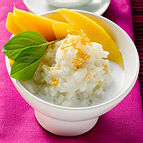 Sweet, Sticky Coconut Rice with Mango
A 1 1/2 cup serving of this classic dessert combination, which is like rice pudding with flavors of coconut milk and topped with fresh mango will tally up to 11 PointsPlus values. Lighten it up: “Thai desserts are made with sticky rice, a highly glutinous rice that will fill you up in five bites, so this is a satisfying dessert for splitting among the table,” says Bank. Or, go for nothing but the mango, which is free — at least in terms of PointsPlus values.
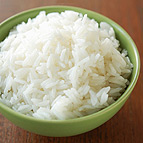 Jasmine rice
Similar to white rice, this Thai variety is slightly sweeter and is frequently prepared with a light touch of spices. One half-cup serving contains about 6 PointsPlus values.
Desserts and Drinks 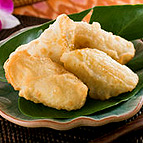 Fried Banana (Kluay Kaek)
While it’s not a truly authentic dish according to Bank, sliced baby bananas, braised in coconut milk and deep-fried, are a popular Thai restaurant pick. Bananas offer good nutrition with 0 PointsPlus values, but Sheth cautions this dessert comes with a high price – about 12 grams of fat from deep frying and possibly more for coconut milk, easily reaching 400 calories, or 5 PointsPlus values. Lighten it up: Go for the sweet, ripe bananas, but drizzled with a little coconut milk, suggests Sheth, for just 1 PointsPlus value. 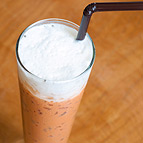 Thai Iced Tea
Made with brewed tea that has been sweetened with condensed milk, or sometimes coconut milk, a 6 ounce glass of thai iced tea
can add 200 calories and 5 PonitsPlus values to your meal. If you really want to enjoy this traditional beverage, order a glass
of water and strech your Thai tea into several drinks, suggests sheth.
*Given that ingredients, cooking methods, and portions sizes can vary greatly among restaurants, all PointsPlus values for restaurant dishes are estimates. |